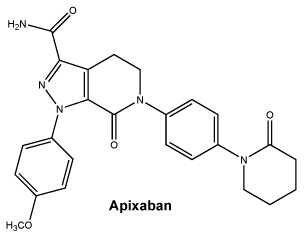SUMMARY CMI
ELIQUIS®
Consumer Medicine Information (CMI) summary
The full CMI on the next page has more details. If you are worried about using this medicine, speak to your doctor or pharmacist.
1. Why am I using ELIQUIS?
ELIQUIS contains the active ingredient apixaban. ELIQUIS is used to treat various conditions.
For more information, see Section 1. Why am I using ELIQUIS? in the full CMI.
2. What should I know before I use ELIQUIS?
Do not use if you have ever had an allergic reaction to apixaban or any of the ingredients listed at the end of the CMI.
Talk to your doctor if you have any other medical conditions, take any other medicines, or are pregnant or plan to become pregnant or are breastfeeding.
For more information, see Section 2. What should I know before I use ELIQUIS? in the full CMI.
3. What if I am taking other medicines?
Some medicines may interfere with ELIQUIS and affect how it works.
A list of these medicines is in Section 3. What if I am taking other medicines? in the full CMI.
4. How do I use ELIQUIS?
- Your doctor will tell you how many tablets you need to take each day.
- Swallow the tablet(s) whole with a full glass of water.
More instructions can be found in Section 4. How do I use ELIQUIS? in the full CMI.
5. What should I know while using ELIQUIS?
| Things you should do |
|
| Things you should not do |
|
| Driving or using machines |
|
| Looking after your medicine |
|
For more information, see Section 5. What should I know while using ELIQUIS? in the full CMI.
6. Are there any side effects?
Like all medicines, ELIQUIS can cause side effects. Your doctor will discuss potential side effects with you and will explain the risks and benefits of your treatment. Some side effects can be serious and you may require medical attention. Contact your doctor immediately or go to the Emergency Department at your nearest hospital if you have any signs or symptoms (changes to your normal self), particularly if they are getting worse or do not go away.
For more information, including what to do if you have any side effects, see Section 6. Are there any side effects? in the full CMI.
FULL CMI
ELIQUIS® (elle-e-kuis)
Active ingredient(s): apixaban (a pix' a ban)
Consumer Medicine Information (CMI)
This leaflet provides important information about using ELIQUIS. You should also speak to your doctor or pharmacist if you would like further information or if you have any concerns or questions about using ELIQUIS.
Where to find information in this leaflet:
1. Why am I using ELIQUIS?
2. What should I know before I use ELIQUIS?
3. What if I am taking other medicines?
4. How do I use ELIQUIS?
5. What should I know while using ELIQUIS?
6. Are there any side effects?
7. Product details
1. Why am I using ELIQUIS?
ELIQUIS contains the active ingredient apixaban. ELIQUIS belongs to a group of medicines called antithrombotic agents. It works by inhibiting a blood clot forming substance called Factor Xa.
ELIQUIS is used to:
- prevent blood clots in your veins after a hip or knee replacement surgery.
After an operation you are at an increased risk of getting blood clots. - treat blood clots occurring in deep veins (Deep Vein Thrombosis [DVT]) and clots in your lungs (Pulmonary Embolism [PE]) and also to prevent these from recurring.
- prevent stroke and blood clots in a condition called atrial fibrillation, which is a type of abnormal heart rhythm.
With atrial fibrillation, part of the heart does not beat the way it should. This can lead to blood clots forming and increase your risk of having a stroke.
2. What should I know before I use ELIQUIS?
Warnings
Do not use ELIQUIS if:
- you are allergic to apixaban, or any of the ingredients listed at the end of this leaflet.
- Always check the ingredients to make sure you can use this medicine.
Some of the symptoms of an allergic reaction may include:
- shortness of breath
- wheezing or difficulty breathing
- swelling of the face, lips, tongue or other parts of the body
- rash, itching or hives on the skin.
Do not use ELIQUIS if you have, or have had, any of the following medical conditions:
- any disease or injury to a body organ that is actively bleeding or at high risk of bleeding e.g. bleeding ulcer in the stomach or bowel, recent bleeding in the brain, cancer at high risk of bleeding
- liver disease which leads to an increased risk of bleeding
- severely reduced kidney function. Your doctor will determine your kidney function
- a recent operation on the brain, spinal column or eye(s)
- recent brain or spine injury
- abnormalities of any blood vessels that may lead to an increase in bleeding
- any blood vessel abnormalities of your oesophagus or "gullet"
- any disease or injury to a body organ that could lead to significant bleeding e.g. stomach ulcers, bowel ulcers.
Do not use ELIQUIS if you are taking the following medicines:
- medicines for fungal infections e.g. ketoconazole, itraconazole, voriconazole or posaconazole, unless they are only applied to the skin
- anti-viral medicines for HIV/AIDS e.g. ritonavir
- other medicines to stop your blood from clotting e.g. heparin, enoxaparin, warfarin, rivaroxaban or dabigatran.
If you are not sure whether you should start taking this medicine, talk to your doctor.
Check with your doctor if you:
- have allergies to any other medicines, foods, preservatives or dyes.
- have ever been hospitalised for a heart condition (heart attack or unstable angina).
- have ever received a stent placed in the coronary arteries of your heart.
- are 75 years or older or if you have or have had any of the following medical conditions which may lead to an increased risk of bleeding:
- a heart condition known as bacterial endocarditis
- type of stroke called "haemorrhagic stroke"
- blood disorders that affect your ability to form clots and stop bleeding
- recent or past ulcer of your stomach or bowel
- moderate or mild kidney disease
- liver disease
- have a lung condition called bronchiectasis
- have had a history of bleeding in your lungs
- high blood pressure that is not controlled with medications.
Your doctor may decide to keep you under closer observation.
Tell your doctor if you:
- have a prosthetic heart valve or severe rheumatic heart disease, especially mitral stenosis (problem with the mitral valve in your heart).
- know that you have a disease called antiphospholipid syndrome (a disorder of the immune system that causes an increased risk of blood clots).
Your doctor who will decide if the treatment may need to be changed. - are having hip or knee replacement surgery and your operation involves a catheter or injection into your spinal column e.g. for epidural or spinal anaesthesia or pain reduction:
Tell your doctor immediately if you get numbness or weakness of your legs or problems with your bowel or bladder after the end of anaesthesia, because urgent care is necessary.
During treatment, you may be at risk of developing certain side effects. It is important you understand these risks and how to monitor for them. See additional information under Section 6. Are there any side effects?
Pregnancy and breastfeeding
Check with your doctor if you are pregnant or intend to become pregnant.
ELIQUIS is not recommended for use in pregnant women. Your doctor can discuss with you the risks and benefits involved.
Talk to your doctor if you are breastfeeding or intend to breastfeed.
ELIQUIS is not recommended during breastfeeding. You should not breastfeed and take ELIQUIS at the same time. The active ingredient in ELIQUIS may be present in breast milk and poses a bleeding risk to the baby. You and your doctor should decide if you will take ELIQUIS or breastfeed.
If you have not told your doctor about any of the above, tell him/her before you start taking ELIQUIS.
Use in Children
There is not enough information to recommend the use of this medicine in children and adolescents under the age of 18 years.
3. What if I am taking other medicines?
Tell your doctor or pharmacist if you are taking any other medicines, including any medicines, vitamins or supplements that you buy without a prescription from your pharmacy, supermarket or health food shop.
Some medicines may be affected by Eliquis or may affect how it works. You may need different amounts of your medicines, or you may need to take different medicines. Your doctor will advise you.
Tell your doctor or pharmacist if you are taking any of the following:
- medicines used to treat fungal infections such as ketoconazole, itraconazole, voriconazole and posaconazole
- anti-viral medicines for HIV/AIDS e.g. ritonavir
- rifampin or rifampicin
- medicines to treat epilepsy such as phenytoin, carbamazepine, phenobarbitone
- St John's wort
- medicines to treat depression such as sertraline, citalopram and venlafaxine
- medicines used to treat pain and inflammation including non-steroidal anti-inflammatory drugs (NSAIDs) such as naproxen or aspirin
- other medicines used to prevent blood clots such as enoxaparin, clopidogrel, ticagrelor, prasugrel, heparin, fondaparinux, bivalirudin, rivaroxaban, dabigatran, dipyridamole
- quinidine
- verapamil
- diltiazem
- amiodarone
- the antibiotic, clarithromycin.
Your doctor and pharmacist have more information on medicines to be careful with or avoid while taking this medicine.
Check with your doctor or pharmacist if you are not sure about what medicines, vitamins or supplements you are taking and if these affect ELIQUIS.
4. How do I use ELIQUIS?
How much to use
Your doctor will tell you how many tablets you need to take each day.
If you are having hip or knee replacement surgery
The recommended dose is one 2.5 mg tablet taken twice a day.
If you have blood clots
The recommended dose to treat blood clots is two 5 mg tablets taken twice a day for 7 days, then one 5 mg tablet taken twice a day.
The recommended dose to prevent blood clots that recur is one 2.5 mg tablet taken twice daily.
If you have atrial fibrillation
The recommended dose is normally one 5 mg tablet taken twice a day.
The recommended dose is one 2.5 mg tablet taken twice a day if you meet any two of the following:
- are 80 years or older
- weigh 60 kilograms or under
- have reduced kidney function.
When to take / use ELIQUIS
ELIQUIS should be used as directed by your doctor.
If you are having hip or knee replacement surgery, it is usual to start taking your tablets 12 to 24 hours after your operation.
Take your medicine at about the same time each day.
Taking it at the same time each day will have the best effect. It will also help you remember when to take it.
How long to take ELIQUIS
Continue taking your medicine for as long as your doctor tells you.
Do not stop taking your medicine or lower the dosage without checking with your doctor.
If you stop taking it suddenly, you may be at an increased risk of developing a blood clot, which can lead to serious problems such as a stroke if you have atrial fibrillation.
If you are having hip or knee replacement surgery
If you have had a hip replacement, you will usually take the tablets for about 5 weeks.
If you have had a knee replacement, you will usually take the tablets for about 2 weeks.
If you have blood clots
To treat blood clots, you will usually take the tablets for up to 6 months. If necessary, you may need to continue taking the tablets, usually at a lower dose, to prevent further blood clots.
If you have atrial fibrillation
Continue taking your medicine for as long as your doctor tells you.
If you require cardioversion
If your abnormal heartbeat needs to be restored by a procedure called cardioversion, take your medicine at the times your doctor tells you, to help prevent blood clots that may result in strokes or other problems.
Continue taking your medicine for as long as your doctor tells you.
How to take ELIQUIS
Swallow the tablet(s) whole with a full glass of water.
If you are unable to swallow the tablet(s) whole, follow the steps below to crush the tablet(s). This will help make sure that all of the crushed tablet(s) will be taken.
- use a mortar and pestle or a similar device to crush the tablet(s)
- transfer the powder to a drinking glass or a small bowl
- when using water, 5% dextrose in water or apple juice:
- add a small amount of water/5% dextrose in water/apple juice (30 mL) to the mortar and pestle/device and stir
- transfer the water/5% dextrose in water/apple juice to the drinking glass
- mix the powder with the water/5% dextrose in water/apple juice and drink right away
- rinse the glass with a small amount of water/5% dextrose in water/apple juice and drink right away. - when using apple sauce:
- mix the powder with a small amount of apple sauce (30 g) in a small bowl and eat with a spoon right away
- add a small amount of water (30 mL) to the mortar and pestle/device and stir
- transfer the water to the bowl and drink right away
- rinse the bowl and the spoon with a small amount of water and drink right away.
If necessary, your doctor may also give you the crushed tablet(s) mixed in 60 mL of water or 5% dextrose in water, through a nasogastric tube.
It does not matter if you take this medicine before or after food.
If you forget to use ELIQUIS
ELIQUIS should be used regularly at the same time each day. If you miss your dose at the usual time, take your next tablet as soon as you remember, then continue taking the tablets as normal (twice a day).
If it is almost time for your next dose, skip the dose you missed and take your next dose when you are meant to.
Do not take a double dose to make up for the dose you missed.
If you are not sure what to do, ask your doctor or pharmacist.
If you have trouble remembering to take your medicine, ask your pharmacist for some hints.
If you use too much ELIQUIS
If you think that you or anyone else may have used too much ELIQUIS, you may need urgent medical attention.
You should immediately:
- phone the Poisons Information Centre
(by calling 13 11 26), or - contact your doctor, or
- go to the Emergency Department at your nearest hospital.
You should do this even if there are no signs of discomfort or poisoning.
Symptoms of an overdose may include bleeding that does not stop. If bleeding occurs, surgery, blood transfusions, or other treatments that may reverse apixaban may be required.
5. What should I know while using ELIQUIS?
Things you should do
If you are about to be started on any new medicine, remind your doctor, dentist or pharmacist that you are taking ELIQUIS.
If you are going to have any surgery or procedure, including dental surgery, tell your surgeon, doctor or dentist that you are taking this medicine.
ELIQUIS should be temporarily stopped before surgery.
Your doctor will tell you when to stop using ELIQUIS before your surgery or procedure.
Your doctor will also tell you when you can start taking ELIQUIS after your surgery.
Tell your doctor that you are taking ELIQUIS if your doctor is planning for you to have an anaesthetic injection in your back (spinal or epidural injection).
If you become pregnant while taking this medicine, tell your doctor immediately.
If you are about to have any blood tests, tell your doctor that you are taking this medicine.
It may interfere with the results of some tests.
Keep all of your doctor's appointments so that your progress can be checked.
Things you should not do
Do not stop using this medicine suddenly or lower the dosage without first checking with your doctor.
If you stop taking it suddenly, your condition may worsen, or you may have serious side effects.
Do not take ELIQUIS to treat any other complaints unless your doctor tells you to.
Do not give your medicine to anyone else, even if they have the same condition as you.
Things to be careful of
ELIQUIS contains lactose. If you have been told by your doctor that you have an intolerance to some sugars, contact your doctor before taking it.
Driving or using machines
Be careful before you drive or use any machines or tools until you know how ELIQUIS affects you.
This medicine is not expected to affect your ability to drive a car or operate machinery.
Looking after your medicine
Keep your tablets in the pack until it is time to take them.
If you take the tablets out of the pack, they may not keep well.
Follow the instructions on the carton on how to take care of your medicine properly.
Store it in a cool dry place away from moisture, heat or sunlight; for example, do not store it:
- in the bathroom or near a sink, or
- in the car or on windowsills.
Keep it where young children cannot reach it.
A locked cupboard at least one-and-a-half metres above the ground is a good place to store medicines. Heat and dampness can destroy some medicines.
Getting rid of any unwanted medicine
If you no longer need to use this medicine or it is out of date or is damaged, take it to any pharmacy for safe disposal.
Do not use this medicine after the expiry date printed on the pack or if the packaging is torn or shows signs of tampering.
6. Are there any side effects?
All medicines can have side effects. If you do experience any side effects, most of them are minor and temporary. However, some side effects may need medical attention.
It can be difficult to tell whether side effects are the result of taking ELIQUIS, effects of your condition or side effects of other medicines you may be taking. For this reason it is important to tell your doctor of any change in your condition.
See the information below and, if you need to, ask your doctor or pharmacist if you have any further questions about side effects.
Serious side effects
| Serious side effects | What to do |
Bleeding:
| Call your doctor straight away or go straight to the Emergency Department at your nearest hospital if you notice any of these serious side effects. |
Other side effects
| Common side effects | What to do |
| Speak to your doctor if you have any of these side effects and they worry you. |
Tell your doctor or pharmacist if you notice anything else that may be making you feel unwell.
Other side effects not listed here may occur in some people.
Some of the other possible side effects (for example, changes in liver or kidney function) can only be found when your doctor does tests from time to time to check your progress.
Reporting side effects
After you have received medical advice for any side effects you experience, you can report side effects to the Therapeutic Goods Administration online at www.tga.gov.au/reporting-problems. By reporting side effects, you can help provide more information on the safety of this medicine.
Always make sure you speak to your doctor or pharmacist before you decide to stop taking any of your medicines.
7. Product details
This medicine is only available with a doctor's prescription.
What ELIQUIS contains
| Active ingredient (main ingredient) | apixaban |
| Other ingredients (inactive ingredients) | lactose lactose monohydrate microcrystalline cellulose croscarmellose sodium sodium lauryl sulfate magnesium stearate hypromellose titanium dioxide glycerol triacetate yellow iron oxide (2.5mg tablets) red iron oxide (5mg tablets) |
Do not take this medicine if you are allergic to any of these ingredients.
This medicine does not contain sucrose, gluten, tartrazine or any other azo dyes.
What ELIQUIS looks like
ELIQUIS 2.5 mg tablets are yellow and round with "893" on one side and "2 1/2" on the other.
They are packed in blister packs in cartons of 10, 14, 20, 30, 60 or 100 tablets.
ELIQUIS 5 mg tablets are pink and oval-shaped with "894" on one side and "5" on the other.
They are packed in blister packs in cartons of 14, 20, 28, 56, 60, 100, 112, 120 and 168 tablets.
Not all pack sizes may be available.
ELIQUIS 2.5 mg tablet: AUST R 172244
ELIQUIS 5 mg tablet: AUST R 193474
Who distributes ELIQUIS
Sponsored and Supplied by:
Bristol-Myers Squibb Australia Pty Ltd
Level 2, 4 Nexus Court
Mulgrave VIC 3170 Australia.
Toll free number: 1800 067 567
Email: [email protected]
Also distributed by:
Pfizer Australia Pty Ltd
Sydney NSW
Toll free number: 1800 675 229
www.pfizermedicalinformation.com.au
ELIQUIS® (apixaban) is a registered trademark of Bristol-Myers Squibb Company
This leaflet was prepared in January 2024.
Published by MIMS March 2024


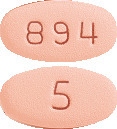
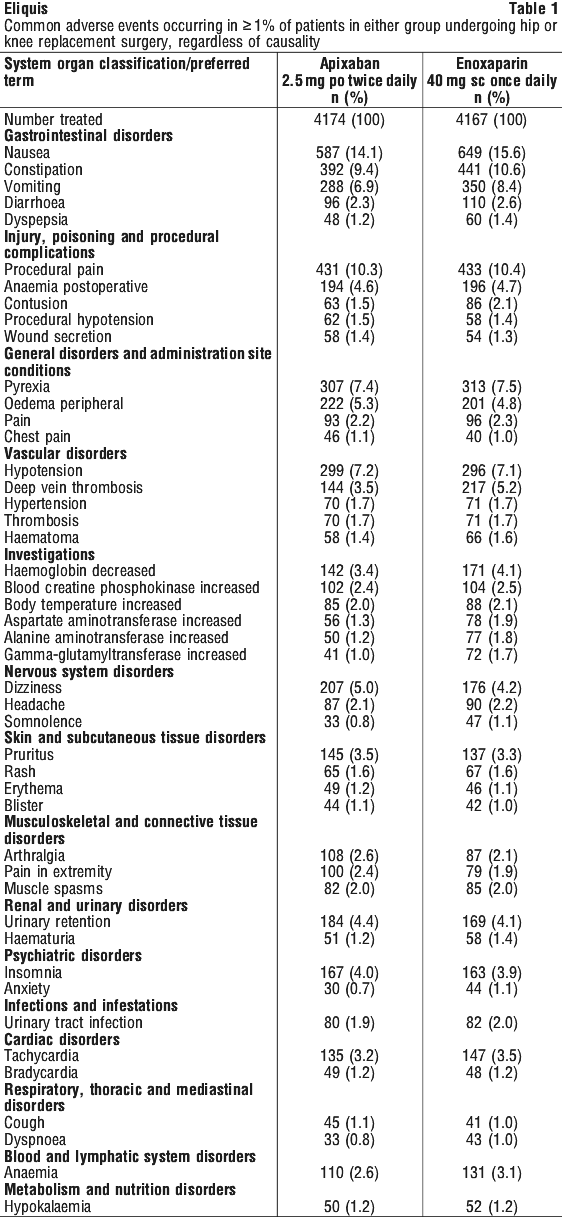
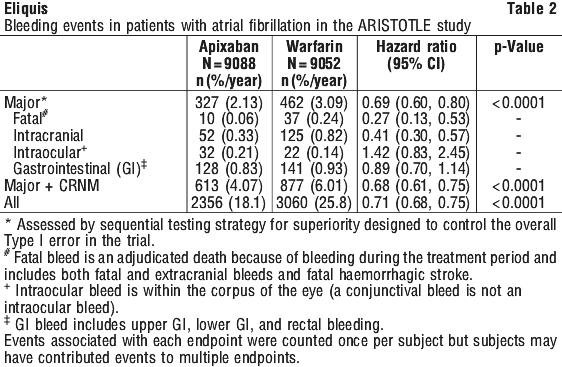 Intracranial haemorrhage was reduced > 50% with apixaban. GUSTO severe and TIMI major bleeding were reduced > 40% with apixaban. Fatal bleeding was reduced > 70% with apixaban.
Intracranial haemorrhage was reduced > 50% with apixaban. GUSTO severe and TIMI major bleeding were reduced > 40% with apixaban. Fatal bleeding was reduced > 70% with apixaban.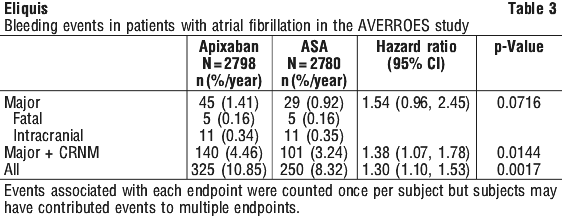 Treatment discontinuation due to bleeding related adverse reactions occurred in 1.5% and 1.3% of patients treated with apixaban and ASA, respectively.
Treatment discontinuation due to bleeding related adverse reactions occurred in 1.5% and 1.3% of patients treated with apixaban and ASA, respectively. Adverse reactions in the ARISTOTLE and AVERROES studies are listed below by system organ classification (MedDRA) and by frequency. The frequency assignments are primarily based on the frequencies observed in the ARISTOTLE study. The adverse reactions observed in the AVERROES study were consistent with those observed in the ARISTOTLE study.
Adverse reactions in the ARISTOTLE and AVERROES studies are listed below by system organ classification (MedDRA) and by frequency. The frequency assignments are primarily based on the frequencies observed in the ARISTOTLE study. The adverse reactions observed in the AVERROES study were consistent with those observed in the ARISTOTLE study. Adverse reactions in the AMPLIFY and AMPLIFY-EXT studies are listed by system organ classification (MedDRA) and by frequency.
Adverse reactions in the AMPLIFY and AMPLIFY-EXT studies are listed by system organ classification (MedDRA) and by frequency.
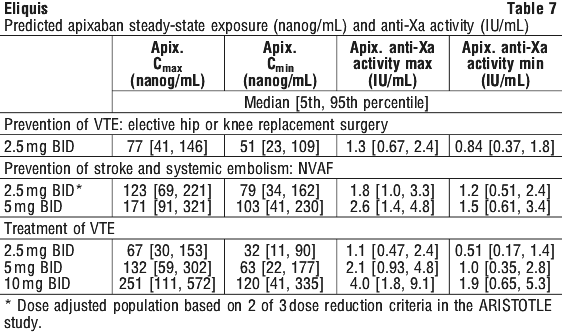 Although treatment with apixaban at the recommended dose does not require routine monitoring of exposure, the use of a calibrated quantitative anti-FXa assay may be useful in exceptional situations where knowledge of apixaban exposure may help to inform clinical decisions, e.g. overdose or emergency surgery.
Although treatment with apixaban at the recommended dose does not require routine monitoring of exposure, the use of a calibrated quantitative anti-FXa assay may be useful in exceptional situations where knowledge of apixaban exposure may help to inform clinical decisions, e.g. overdose or emergency surgery.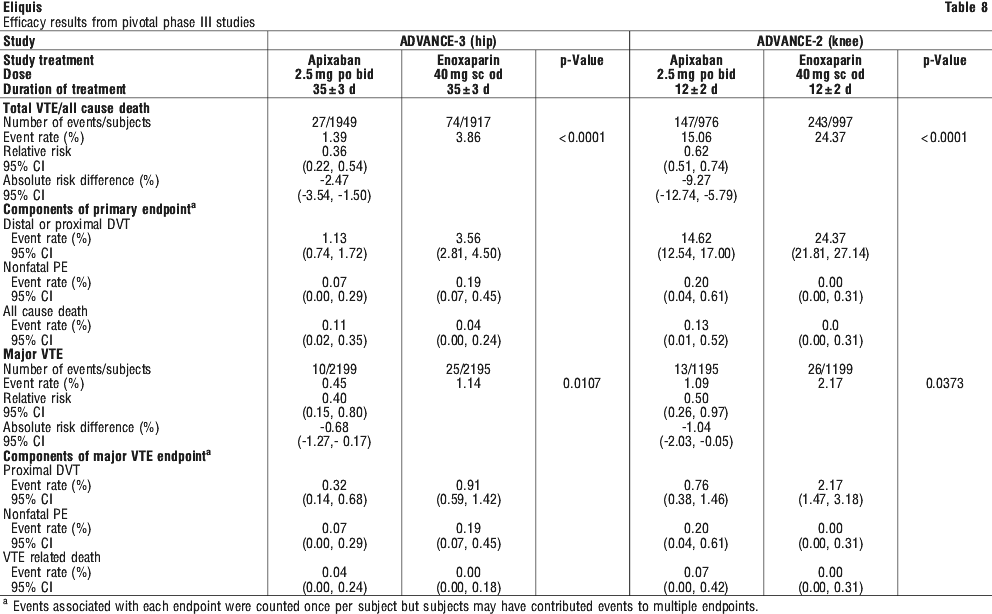 The safety endpoints of major bleeding, the composite of major and clinically relevant nonmajor (CRNM) bleeding, and all bleeding showed similar rates for patients treated with apixaban 2.5 mg compared with enoxaparin 40 mg (see Table 8). Major bleeding was defined as a decrease in haemoglobin of 20 g/L or more over a 24 hour period, transfusion of 2 or more units of packed red cells, bleeding into a critical site (e.g. intracranial haemorrhage) or fatal. CRNM bleeding was defined as significant epistaxis, gastrointestinal bleed, significant haematuria, significant haematoma, bruising or ecchymosis, or haemoptysis. All the bleeding criteria included surgical site bleeding.
The safety endpoints of major bleeding, the composite of major and clinically relevant nonmajor (CRNM) bleeding, and all bleeding showed similar rates for patients treated with apixaban 2.5 mg compared with enoxaparin 40 mg (see Table 8). Major bleeding was defined as a decrease in haemoglobin of 20 g/L or more over a 24 hour period, transfusion of 2 or more units of packed red cells, bleeding into a critical site (e.g. intracranial haemorrhage) or fatal. CRNM bleeding was defined as significant epistaxis, gastrointestinal bleed, significant haematuria, significant haematoma, bruising or ecchymosis, or haemoptysis. All the bleeding criteria included surgical site bleeding.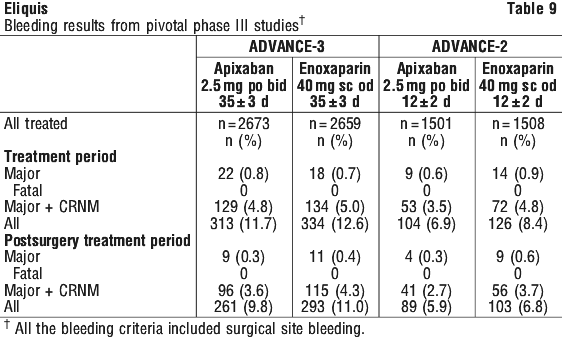
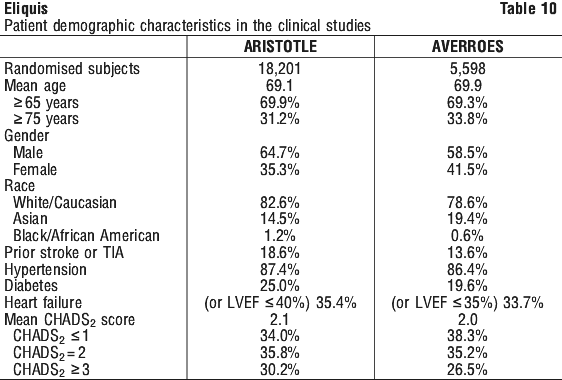
 Centres were ranked post hoc by the percentage of time that warfarin treated patients were in therapeutic range (INR 2-3). Findings for stroke/ systemic embolism, major bleeds, and all cause mortality are shown for centres above and below the median level of INR control in Table 12. The benefits of apixaban relative to warfarin were consistent in patients enrolled at centres with INR control below or above the median.
Centres were ranked post hoc by the percentage of time that warfarin treated patients were in therapeutic range (INR 2-3). Findings for stroke/ systemic embolism, major bleeds, and all cause mortality are shown for centres above and below the median level of INR control in Table 12. The benefits of apixaban relative to warfarin were consistent in patients enrolled at centres with INR control below or above the median.

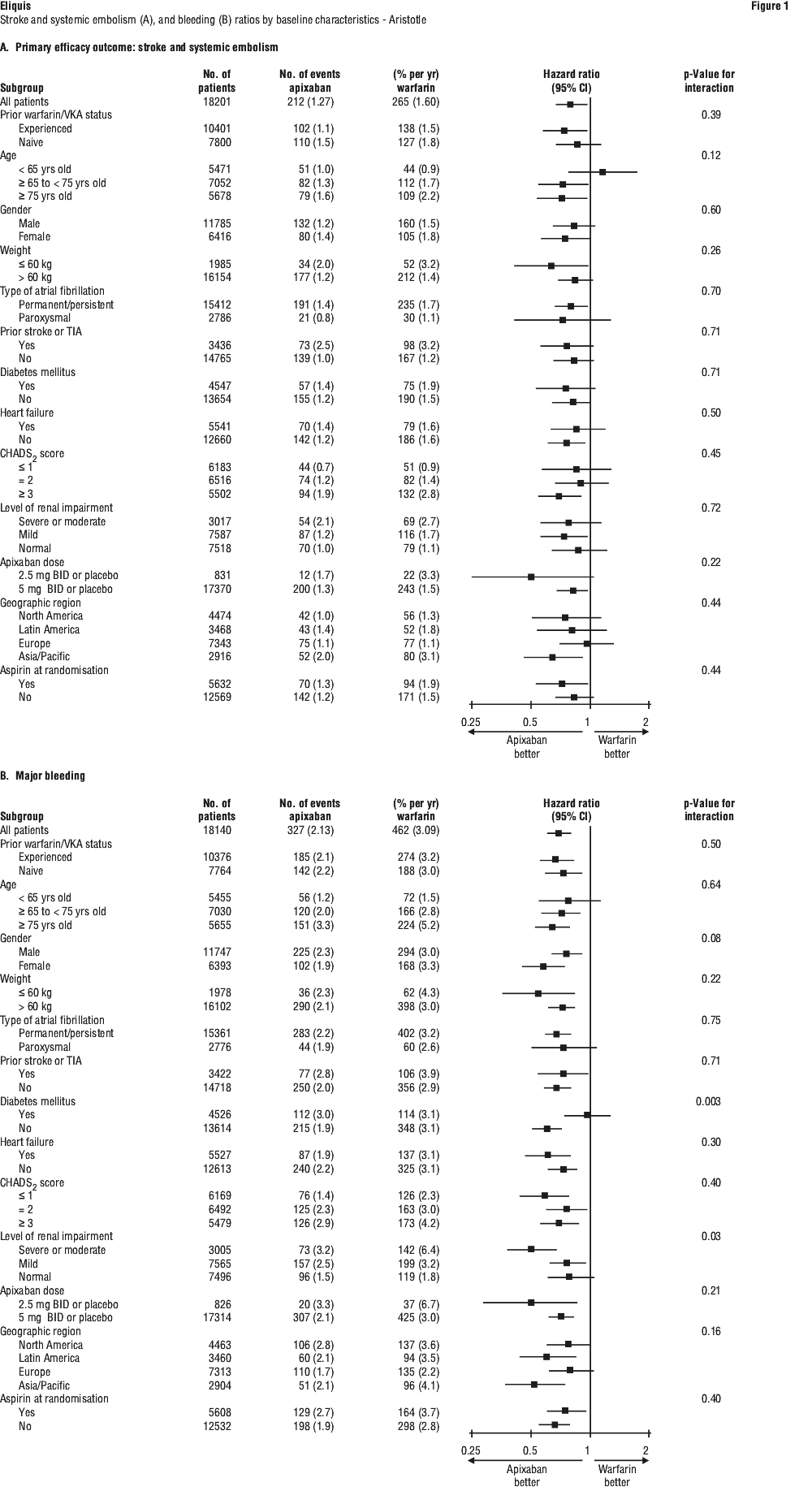 The ARISTOTLE study shows that the risk of stroke, death and major bleeding increases significantly with age. Eliquis compared with warfarin was shown to reduce these outcomes in a consistent manner regardless of age (see Section 4.4, Use in the elderly).
The ARISTOTLE study shows that the risk of stroke, death and major bleeding increases significantly with age. Eliquis compared with warfarin was shown to reduce these outcomes in a consistent manner regardless of age (see Section 4.4, Use in the elderly).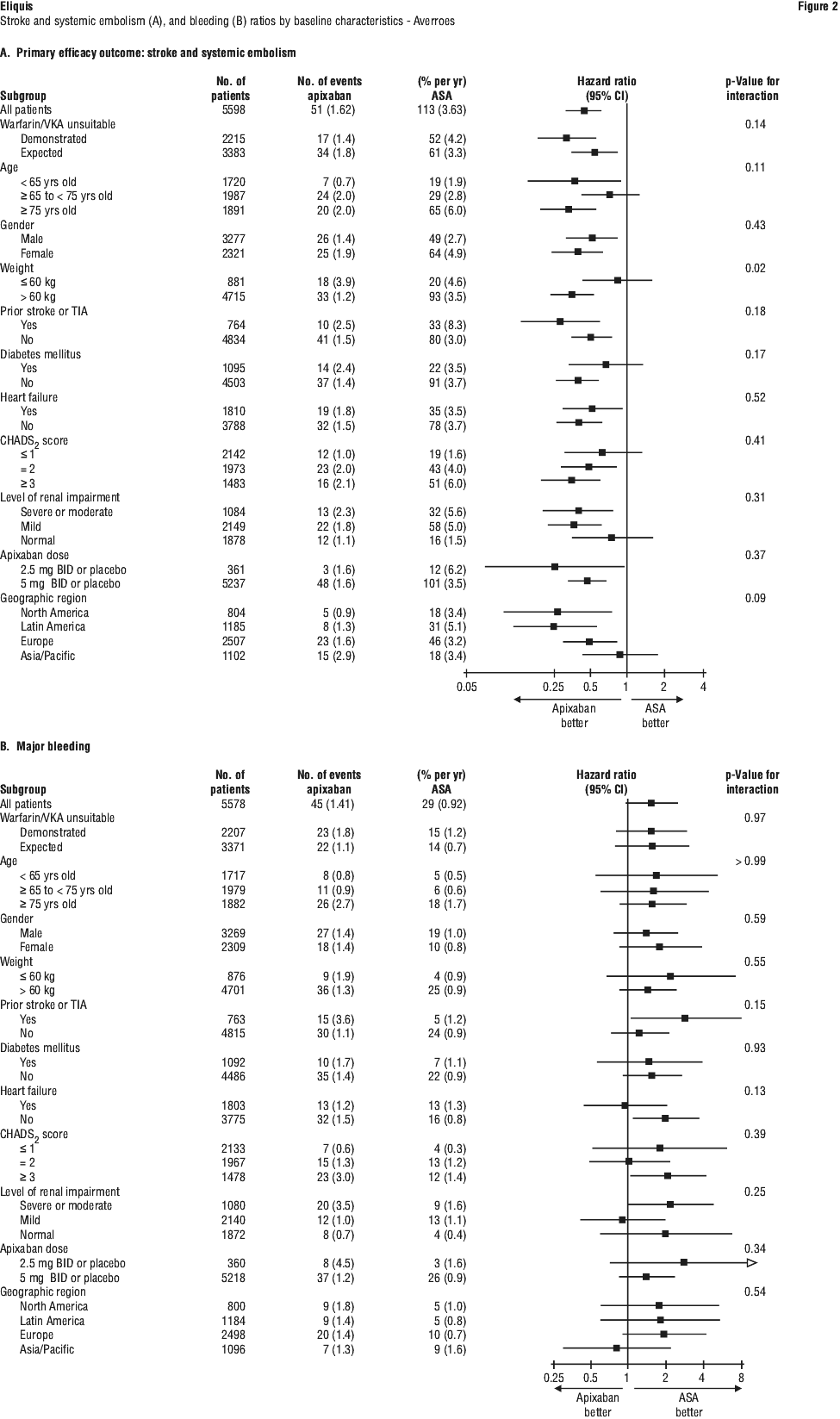 In a clinical study in high risk acute coronary syndrome patients, as characterised by advanced age and multiple cardiac and noncardiac comorbidities (e.g. diabetes, heart failure), receiving apixaban 5 mg twice daily versus placebo, a significant increase in bleeding risk, including gastrointestinal and intracranial bleeding, was reported with the triple combination of apixaban, ASA and clopidogrel (see Section 4.5, Effect of other medicines on apixaban).
In a clinical study in high risk acute coronary syndrome patients, as characterised by advanced age and multiple cardiac and noncardiac comorbidities (e.g. diabetes, heart failure), receiving apixaban 5 mg twice daily versus placebo, a significant increase in bleeding risk, including gastrointestinal and intracranial bleeding, was reported with the triple combination of apixaban, ASA and clopidogrel (see Section 4.5, Effect of other medicines on apixaban).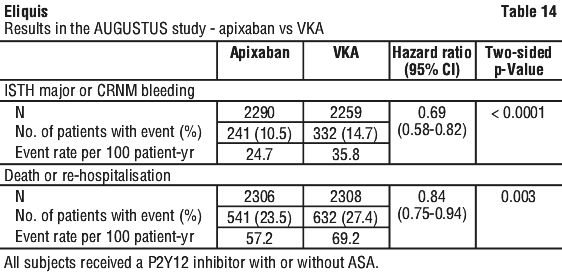 For the ASA versus placebo comparison, the addition of ASA to anticoagulation (with either apixaban or VKA) on top of P2Y12 inhibitor significantly increased the risk of ISTH major or CRNM bleeding (HR = 1.88, 95% CI 1.58, 2.23; two-sided p < 0.0001). A subgroup analysis found that concomitant use of ASA resulted in a near doubling of the risk of major or CRNM bleeding in both apixaban-treated and VKA treated subjects. See Table 15 for results of the primary safety outcome.
For the ASA versus placebo comparison, the addition of ASA to anticoagulation (with either apixaban or VKA) on top of P2Y12 inhibitor significantly increased the risk of ISTH major or CRNM bleeding (HR = 1.88, 95% CI 1.58, 2.23; two-sided p < 0.0001). A subgroup analysis found that concomitant use of ASA resulted in a near doubling of the risk of major or CRNM bleeding in both apixaban-treated and VKA treated subjects. See Table 15 for results of the primary safety outcome.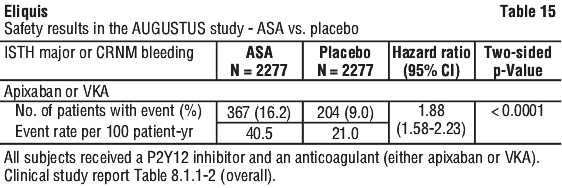
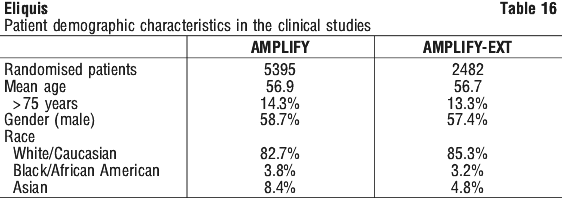
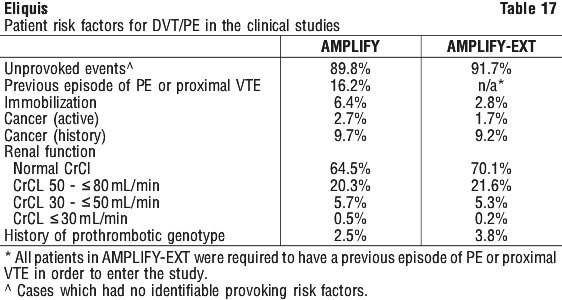
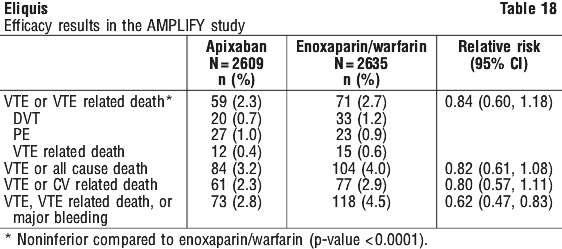 Figure 3 is a plot of the time from randomisation to the occurrence of the first primary efficacy endpoint event in the two treatment groups in the AMPLIFY study.
Figure 3 is a plot of the time from randomisation to the occurrence of the first primary efficacy endpoint event in the two treatment groups in the AMPLIFY study.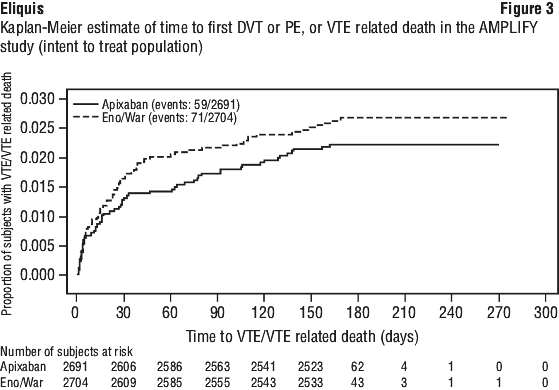 Apixaban efficacy in initial treatment of VTE was consistent between patients who were treated for a PE [Relative Risk 0.9, 95% confidence interval (0.5, 1.6)] or DVT [Relative Risk 0.8, 95% confidence interval (0.5, 1.3)]. Efficacy across subgroups, including age, gender, renal function, body mass index (BMI), extent of index PE, location of DVT thrombus, and prior parenteral heparin use was generally consistent (see Figure 4).
Apixaban efficacy in initial treatment of VTE was consistent between patients who were treated for a PE [Relative Risk 0.9, 95% confidence interval (0.5, 1.6)] or DVT [Relative Risk 0.8, 95% confidence interval (0.5, 1.3)]. Efficacy across subgroups, including age, gender, renal function, body mass index (BMI), extent of index PE, location of DVT thrombus, and prior parenteral heparin use was generally consistent (see Figure 4).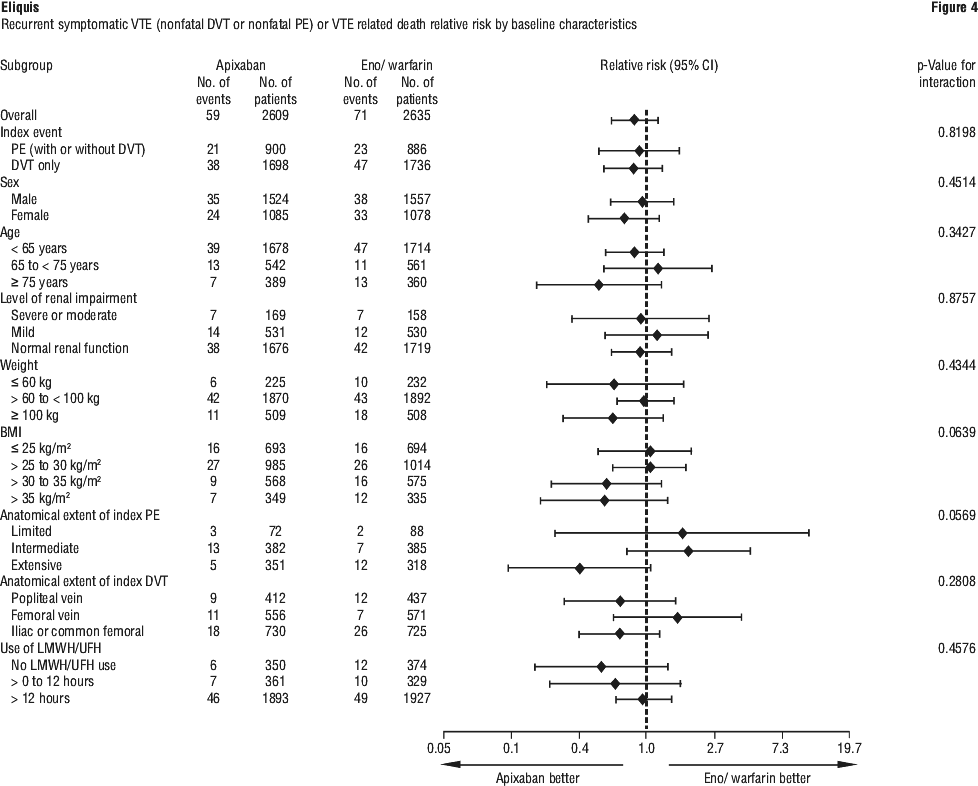 The primary safety endpoint was major bleeding. In the study, apixaban was statistically superior to enoxaparin/ warfarin in the primary safety endpoint [Relative Risk 0.31, 95% confidence interval (0.17, 0.55), p-Value < 0.0001] (see Table 19).
The primary safety endpoint was major bleeding. In the study, apixaban was statistically superior to enoxaparin/ warfarin in the primary safety endpoint [Relative Risk 0.31, 95% confidence interval (0.17, 0.55), p-Value < 0.0001] (see Table 19).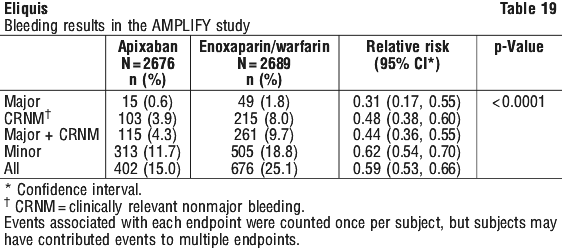 The adjudicated major bleeding and CRNM bleeding at any anatomical site was generally lower in the apixaban group compared to the enoxaparin/ warfarin group. Adjudicated ISTH major gastrointestinal bleeding occurred in 6 (0.2%) apixaban treated patients and 17 (0.6%) enoxaparin/ warfarin treated patients. Adjudicated intracranial bleeding occurred in 3 (0.1%) apixaban treated patients and 6 (0.2%) enoxaparin/ warfarin treated patients.
The adjudicated major bleeding and CRNM bleeding at any anatomical site was generally lower in the apixaban group compared to the enoxaparin/ warfarin group. Adjudicated ISTH major gastrointestinal bleeding occurred in 6 (0.2%) apixaban treated patients and 17 (0.6%) enoxaparin/ warfarin treated patients. Adjudicated intracranial bleeding occurred in 3 (0.1%) apixaban treated patients and 6 (0.2%) enoxaparin/ warfarin treated patients. Figure 5 is a plot of the time from randomisation to the occurrence of the first primary efficacy endpoint event in the three treatment groups in the AMPLIFY-EXT study.
Figure 5 is a plot of the time from randomisation to the occurrence of the first primary efficacy endpoint event in the three treatment groups in the AMPLIFY-EXT study.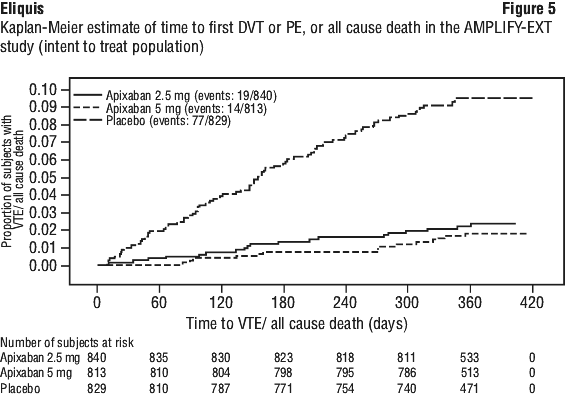 Apixaban efficacy for prevention of a recurrence of a VTE was maintained across subgroups, including age, gender, BMI, and renal function.
Apixaban efficacy for prevention of a recurrence of a VTE was maintained across subgroups, including age, gender, BMI, and renal function.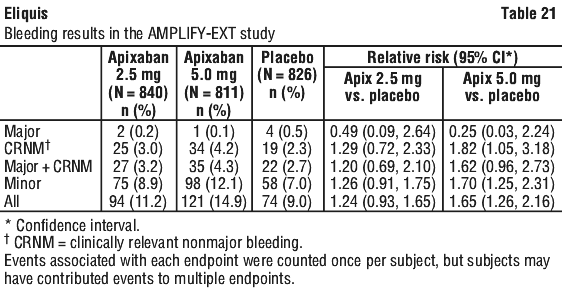 Figure 6 is a plot of the time from randomisation to the occurrence of the first major or clinically relevant nonmajor bleeding event in the three treatment groups in the AMPLIFY-EXT study.
Figure 6 is a plot of the time from randomisation to the occurrence of the first major or clinically relevant nonmajor bleeding event in the three treatment groups in the AMPLIFY-EXT study.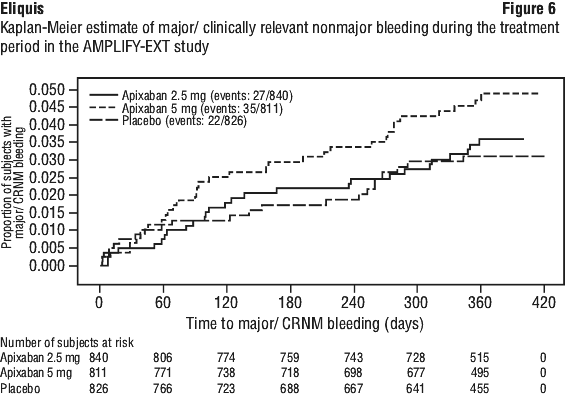 ISTH major gastrointestinal bleeding occurred in 1 (0.1%) apixaban treated patient at the 5 mg twice daily dose, no patients at the 2.5 mg twice daily dose, and 1 (0.1%) placebo treated patient. Adjudicated intracranial bleeding occurred in none of the apixaban treated patients and 1 (0.1%) placebo treated patient.
ISTH major gastrointestinal bleeding occurred in 1 (0.1%) apixaban treated patient at the 5 mg twice daily dose, no patients at the 2.5 mg twice daily dose, and 1 (0.1%) placebo treated patient. Adjudicated intracranial bleeding occurred in none of the apixaban treated patients and 1 (0.1%) placebo treated patient. There was no impact of impaired renal function on peak concentration of apixaban. There was an increase in apixaban exposure correlated to decrease in renal function, as assessed via measured creatinine clearance. In individuals with mild (creatinine clearance 51-80 mL/min), moderate (creatinine clearance 30-50 mL/min) and severe (creatinine clearance 15-29 mL/min) renal impairment, apixaban plasma concentrations (AUC) were increased 16, 29, and 44% respectively, compared to individuals with normal creatinine clearance. Renal impairment had no evident effect on the relationship between apixaban plasma concentration and anti-FXa activity.
There was no impact of impaired renal function on peak concentration of apixaban. There was an increase in apixaban exposure correlated to decrease in renal function, as assessed via measured creatinine clearance. In individuals with mild (creatinine clearance 51-80 mL/min), moderate (creatinine clearance 30-50 mL/min) and severe (creatinine clearance 15-29 mL/min) renal impairment, apixaban plasma concentrations (AUC) were increased 16, 29, and 44% respectively, compared to individuals with normal creatinine clearance. Renal impairment had no evident effect on the relationship between apixaban plasma concentration and anti-FXa activity.